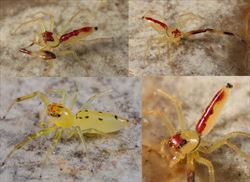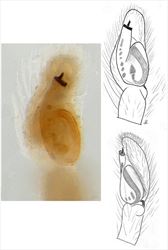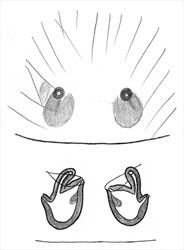
Examples of live Astilodes
Illustrator (and ©) I.R. Macaulay

Aspects of the general morphology of Astilodes
Illustrators (and ©) B.J. Richardson (CSIRO), M. Zabka (diag.)

Palp morphology of Astilodes
Illustrators (and ©) R. Whyte, M. Zabka (diag.)

Epigyne morphology of Astilodes
Illustrator (and ©) M. Zabka
Astilodes Zabka, 2009
Taxonomy
Astilodes has one Australian species: Astilodes mariae, part of an Australasian clade (Maddison et al 2008) including Adoxotoma, Arasia, Astia, Helpis, Jacksonoides, Megaloastia, Parahelpis, Sondra and Tauala. Genera from Indonesia (Katya) and the Philippines (Orthrus) may also be part of this group (Maddison 2015). Further information on the genus and described species can be found in Richardson and Żabka (2017) and Whyte and Anderson (2017).
Description
Astilodes mariae is a slender, extremely-elongate, small to medium-sized spider, ranging in body length from 3 to 7 mm. The carapace is high in profile, highest at the posterior lateral eyes. The head, viewed from above, is rounded (male) or pear-shaped (female), widest behind the posterior lateral eyes. The abdomen is elongate. Females have somewhat fatter abdomens than the males and are mostly very pale to translucent yellow with orange hairs in the eye quadrangle and black spots and marks on the abdomen. Males have a dark band around the rim of the rear of the carapace, and deep magenta pigmentation in the eye quadrangle and along the upper surface of the abdomen. The chelicerae have four retromarginal teeth (plurident) and three or more teeth on the promargin. The first pair of legs is much longer and thicker than the others. The tibia and metatarsi have distinctive spines.
The male’s palp has an oddly-shaped short, straight, slightly-bifurcate embolus arising from a tubular base. The tibia has a hooked retro-lateral tibial apophysis pointing ventrally (away from the cymbium) and a bulge nearby.
The female epigyne is poorly sclerotised, the insemination ducts initially moving laterally towards the sides, then back slightly to the round or pear-shaped spermathecae.
Biology
Astilodes mariae is found in tropical and subtropical rainforest. Being pale to translucent spiders, they are well-camouflaged in greenery especially as juveniles, while the adults become more colourful, especially the male. The light yellow-green colour, soluble in alcohol, is lost immediately on preservation.
Distribution
Astilodes mariae is known from scattered localities in coastal Queensland and New South Wales, from Lockerbie Scrub, Cape York to Manning Point NSW (Whyte unpubl., Richardson unpubl.).
References
Gardzińska, J. & Żabka, M. 2010. A new genus and five new species of Astieae (Araneae: Salticidae) from Australia, with remarks on distribution. Zootaxa 2526, 37-53.
Maddison, W.P. 2015. A phylogenetic classification of jumping spiders (Araneae: Salticidae). Journal of Arachnology 43, 231-292.
Maddison, W.P., Bodner, M.R. & Needham, K.M. 2008. Salticid spider phylogeny revisited, with the discovery of a large Australian clade (Araneae: Salticidae). Zootaxa 1893, 49-64.
Richardson, B.J. & Żabka, M. 2017. Salticidae. Arachnida: Araneomorphae. Canberra, Australian Faunal Directory. Australian Biological Resources Study, at https://biodiversity.org.au/afd/taxa/SALTICIDAE.
Whyte, R. & Anderson, G. 2017. A Field Guide to Spiders of Australia. CSIRO Publishing: Clayton.
Żabka, M, (2009), Salticidae (Arachnida: Araneae) from Oriental, Australian and Pacific Regions: Astilodes and Urogelides, new genera from Australia. Insect Systematics and Evolution 40, 349-359.
* The information sheet should be interpreted in the context of the associated diagrams and photographs. Diagrams explaining anatomical terms can be found in the ‘Salticidae’ pictures at the beginning of the list of genera.